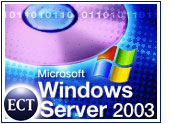
In a bid to lure IBM mainframe customers, Microsoft said it would work with Micro Focus International to promote the migration of applications from mainframes to Windows servers.
The two companies said many organizations recognize the value of legacy applications running on mainframes but also want the added flexibility of using Web services. The companies made it clear their target was users of IBM mainframes, some older versions of which are having service and support phased out over time.
Micro Focus will offer a server migration package that enables Customer Information Control Systems, a popular transaction-tracking system, and Cobol-based applications to be moved onto the Windows platform.
“We recognize the significant investments many organizations have made in legacy applications,” said Micro Focus CEO Tony Hill.
Migratory Enterprises
Microsoft said the lure of using Intel-based and Windows-loaded servers that enable the use of the .NET platform is strong, but that some companies balk at the potential disruption involved with making the switch away from old-fashioned mainframes.
Customers want to move away from “monolithic and expensive mainframe systems” to more “agile” servers, said Eric Rudder, senior vice president of the Server and Tools Business at Microsoft.
The ability to cut costs is a major selling point for Microsoft and Micro Focus. At an event marking the launch of a partnership, one customer who made the switch, the Montreal-based book-club division of Bertelsmann AG, said it had cut both time and expense by switching from a mainframe to a cluster of Intel servers.
IBM this week unveiled its own options for companies eager to upgrade to newer machines, using the 40th anniversary of its first mainframe to unveil a new zSeries 890 “midsized” mainframe with a price tag more within the reach of smaller businesses. Big Blue also has its own suite of technologies aimed at companies that want to bring Web services into the enterprise while maintaining existing applications.
On the Prowl
Microsoft has been an aggressive newsmaker in recent weeks. After being whacked by the European Union with a record-breaking fine and stiff sanctions that it will appeal in court, Microsoft brokered a massive settlement deal with Sun Microsystems that ends years of legal disputes between those companies.
That deal could be worth well over $2 billion in up-front payments and ongoing licensing fees to Sun, but helps clear the way for Microsoft to focus on its other competitive challenges, said Directions on Microsoft analyst Matt Rosoff.
Rosoff told the E-Commerce Times that Microsoft is responding to the various threats to its market position in an aggressive way now that it knows that legal battles will tie up the EU anti-trust case for some time.
“They’re back to executing, to getting more companies to see the value that their products have,” Rosoff said. “And it’s no accident that a lot of what they’re doing is partnering and settling with other companies. They understand that customers want technology that can work with what they already have or what they might buy in the future.”
Customers a Top Priority
Gartner analyst John Phelps told the E-Commerce Times that upcoming discontinuation of support for some older mainframes by IBM will push some companies to act, but said IBM has also made keeping those customers a top priority, most recently with its low-end mainframe options.
“It’s going to come down to a cost consideration in most instances,” Phelps said, adding that making dramatic switches can increase both hardware and software costs. “Any increase in performance and long-range savings will have to pay back the up-front cost quickly or else companies will just stick with what they’ve got until the bitter end.”
Microsoft Chairman Bill gates also indicated at a technology trade show late last month that the much-hyped Longhorn version of Windows could be available in 2006, the first solid date the company has put on the release and a sign to many that Microsoft understands the competitive need to get the release into users’ hands.














































Social Media
See all Social Media